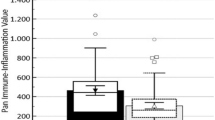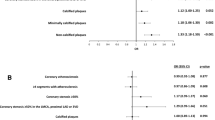Summary
BACKGROUND AND AIM: Raised levels of inflammation markers are associated with worse prognosis in patients with coronary artery disease. It is generally believed, although it has never been proven, that inflammation markers are released from (un)stable plaques in coronary arteries. We investigated this issue by directly comparing levels of inflammation markers in coronary and systemic blood. PATIENTS AND METHODS: Patients with acute coronary syndrome (N = 11), stable angina pectoris (N = 10) and controls with noncoronary origin of chest pain (N = 9) were included in the study. Intracoronary blood samples were taken at the culprit lesion in the coronary artery in patients with acute coronary syndrome and from any coronary artery in the other two groups, together with systemic blood samples from the femoral vein and artery. Levels of high-sensitivity C reactive protein (hsCRP), interleukin 6, interleukin 8, interleukin 10, soluble receptor for interleukin 2 (tR IL-2) and myeloperoxidase were measured in all samples. RESULTS: We found significantly elevated levels of hsCRP and interleukin 10 in patients with acute coronary syndrome compared with patients with stable angina and the control patients. Notably, we did not find any difference between intracoronary and systemic levels of any inflammatory marker in patients with acute coronary syndrome. Furthermore, no difference between intracoronary and systemic levels of markers was present in patients with stable angina or in the control group. CONCLUSIONS: We observed that excess circulating inflammation markers, being characteristic of unstable coronary artery disease, are released from noncoronary sources. Thus, it may be speculated that systemic inflammation precedes local inflammation at the plaques, thereby transforming coronary disease from a stable to an unstable form.
Similar content being viewed by others
References
Libby P, Ridker PM, Maseri A (2002) Inflammation and atherosclerosis. Circulation 105: 1135–43
Unger F (2008) Health is wealth – toward a European lead market in health care. Acta Medico-Biotechnica 1: 11–8
Ishikawa T, Hatakayama K, Imamura T, Date H, Shibata Y, Hikichi Y, et al (2003) Involvement of C-reactive protein obtained by directional coronary atherectomy in plaque instability and developing restenosis in patients with stable or unstable angina pectoris. Am J Cardiol 91: 287–92
Brueckmann M, Bertsch T, Lang S, Sueselbeck T, Wolpert C, Kaden JJ, et al (2004) Time course of systemic markers of inflammation in patients presenting with acute coronary syndromes. Clin Chem Lab Med 42: 1132–9
Mezaki T, Matsubara T, Hori T, Higuchi K, Nakamura A, Nakagawa I, et al (2003) Plasma levels of soluble thrombomodulin, C-reactive protein, and serum amyloid A protein in the atherosclerotic coronary circulation. Jpn Heart J 44: 601–12
Hsu RB, Tsay YG, Lee CM, Chen RJ, Wang SS, Chu SH (2003) Soluble inflammatory markers in coronary sinus and peripheral blood of heart transplant recipients. Clin Transplant 17: 331–7
Matsubara T, Ishibashi T, Hori T, Ozaki K, Mezaki T, Tsuchida K, et al (2003) Association between coronary endothelial dysfunction and local inflammation of atherosclerotic coronary arteries. Mol Cell Biochem 249: 67–73
Inoue T, Kato T, Uchida T, Sakuma M, Nakajima A, Shibazaki M (2005) Local release of C-reactive protein from vulnerable plaque or coronary arterial wall injured by stenting. J Am Coll Cardiol 46: 239–45
Author information
Authors and Affiliations
Corresponding author
Rights and permissions
About this article
Cite this article
Kirbiš, S., Breskvar, U., Šabovič, M. et al. Inflammation markers in patients with coronary artery disease – comparison of intracoronary and systemic levels. Wien Klin Wochenschr 122 (Suppl 2), 31–34 (2010). https://doi.org/10.1007/s00508-010-1343-z
Issue Date:
DOI: https://doi.org/10.1007/s00508-010-1343-z




